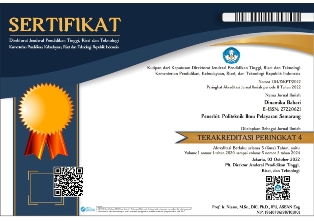Manfaat dan Dampak Digitalisasi Pada Bisnis Logistik Di Era New Normal
Abstract
The new normal is an attempt to normalize everything new. A number of new things during the Covid-19 pandemic are related to the use of digital technology to sustain community activities during lockdowns in a number of countries. Information technology that has been used by the public to obtain and manage information is a major need in the face of this new normal. Previously people have been familiar with the pattern of work from home (work from home) that requires internet at high speed. The purpose of this research is first to find out the benefits and impacts of digitalization in the Indonesian logistics business sector and secondly to know the constraints of the use of digitalization of Indonesian logistics business. Methods of reasoning are thought processes derived from empirical observations that produce a number of concepts and understandings. The conclusions obtained in this study showed that the impact of technology helped logistics industry players to manage inventory, order processing, control supplier status. The obstacle faced is the problem of the possibility of goods experiencing damage on the road or worse not reaching the destination, and payments made by customers are not verified.
Downloads
References
Bhandari, R. (2013). Impact of Technology on Logistics and Supply Chain Management. IOSR Journal of Business and Management (IOSR-JBM), 19-24.
Fischer, F., Kollar, I., Ufer, S., Sodian, B., Hussmann, H., Pekrun, R., . . . Eberlea, J. (2014). Scientific Reasoning and Argumentation: Advancing an Interdisciplinary Research Agenda in Education . Frontline Learning Research, 5, 28-45.
Fruth, M., & Teuteberg, F. (2017). Digitization in maritime logistics—What is there and what is missing?, , . Cogent Business & Management, 4(1).
International Finance Corporation. (2020). The Impact of COVID-19 on Logistics. World Bank Group.
Kayikci, Y. (2018). Sustainability impact of digitization in logistics. Procedia Manufacturing, 21, 782–789.
Kumorojati, G. S., & Mahardhika, G. P. (2021). Digitalisasi Proses Bisnis Penjualan. Studi Kasus PT Limas Indra Group. AUTOMATA, 2(2).
Madden, A. (2000). A definition of information. Aslib Proceedings, 52, pp. 343-349.
Sharipbekova, K., & Raimbekov, Z. (2018). Influence of Logistics Efficiency on Economic Growth of the CIS Countries. European Research Studies Journal, XXI(2), 678-690.
Wareewanich, T., Sukpasjaroen, K., Chankoson, T., Ruaengmaneeya, N., & Raviyan, N. (2019, April). Customer Relationship Management (CRM) and Logistic Customer Satisfaction. International Journal of Supply Chain Management IJSCM, 8(2), 211-221.
Wernicke, C., Saab, S., & Kleinaltenkamp, M. (2014). CASE: Managing Key Account Disruption in the Logistics Industry. J Bus Mark Manag , 7(3), 406–413.
Wilson, M. N., Iravo, M. A., Tirimba, O. I., & Ombui, K. (2015, April). Effects of Information Technology on Performance of Logistics Firms in Nairobi County. International Journal of Scientific and Research Publications , 5(4).














